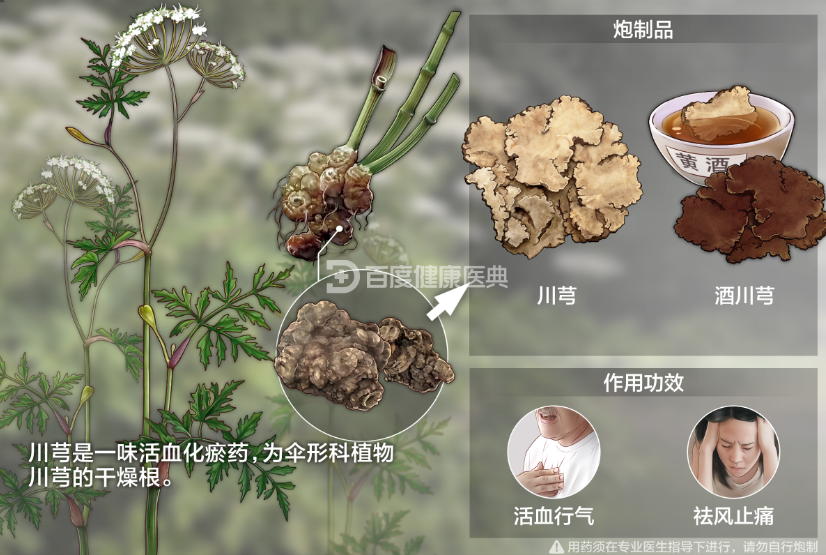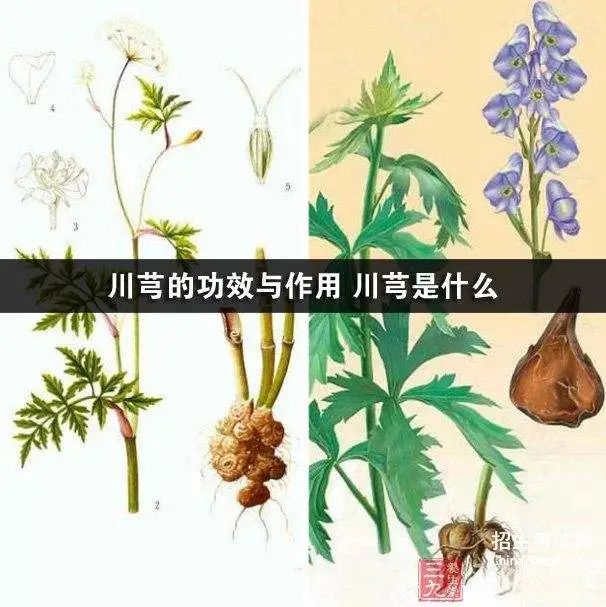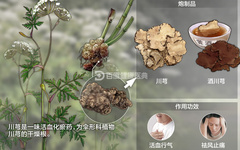Invigorating blood circulation, dispelling blood stasis, relieving wind and pain, and calming
First, for severe headaches, Chuanxiong (Chuanxiong Rhizoma) is used to promote qi and relieve stagnation, effective for various types of wind-cold headaches, migraines, and vascular headaches;
Second, it is used to invigorate blood and dispel stasis, frequently treating gynecological disorders such as irregular menstruation and amenorrhea;
Third, it is used in the treatment of coronary heart disease, such as chest tightness, shortness of breath, and pain in the precordial area;
Fourth, it is often used in the treatment of certain surgical conditions, such as trauma and injuries, to invigorate qi and blood.
Fifth, suitable population: those with blood stasis constitution, individuals with irregular menstruation, and headache patients.
Sixth, contraindicated populations: those with yin deficiency constitution, pregnant women, and patients with hypertension.
However, when using Chuanxiong, attention should be paid to several situations, such as in patients with hypertension, yang hyperactivity, and yin deficiency with excess fire, where caution or compatibility in application is necessary. Chuanxiong is known as a qi medicine in the blood, ascending to the vertex and descending to the feet, but should be used according to the location of the disease and different combinations.
Seventh, not suitable for simultaneous consumption: Chuanxiong should not be consumed with spicy and irritating foods, as it may lead to gastrointestinal discomfort, causing abdominal pain and diarrhea.
Spicy and irritating foods
4. Method of consumption
Decoction
Take an appropriate amount of Chuanxiong, wash it clean, place it in a decoction vessel, add water, bring to a boil over high heat, then reduce to low heat and simmer for about 30 minutes, filtering out the residue before drinking. It can also be decocted with other herbs under the guidance of a physician.
Infused liquor
Take an appropriate amount of Chuanxiong, soak it in white liquor for about a week before drinking, with a daily intake of about 30ml, and this should be done under the guidance of a physician.

【Pharmacological Knowledge】
【Chinese Herbal Name】Chuanxiong (川芎)
【Alias】Shanjuqiong, Xiongshun, Xiangguo, Huxiang, Maxian, Xixiong, Guanxiong.
【English Name】Chuanxiong Rhizoma.
【Source】The rhizome of the plant Ligusticum chuanxiong Hort. from the Umbelliferae family.
【Plant Morphology】Height 0.5-1 cm. The rhizome is thick, with prominent nodes and short internodes. The stem is erect, with longitudinal grooves and branches. The basal leaves have petioles 10-20 cm long, and the leaf blades are ovate-triangular, 15-30 cm long and 10-15 cm wide, with 3-4 times pinnately compound lobes, 4-6 pairs of leaflets, and the terminal lobes are pinnately lobed. The stem leaves are similar to the basal leaves but simplified, without petioles, and once pinnately divided. The compound umbel is terminal or lateral, with a diameter of 6-8 cm during the fruiting period. There are 5-6 total bracts, linear, with 15-30 rays, nearly equal in length, 3-5 cm long, and 5-8 small total bracts, linear, shorter than the flower stalks, and reflexed. The calyx teeth are undeveloped, the petals are white, obovate, with a wedge-shaped base, and the style is as long as the fruit, curved downward. The fruit is oval-shaped, 2-3 mm long and 1.5-2 mm wide, with 1-3 oil tubes in the grooves and 4-6 fused oil tubes on the flat side. The flowering period is from July to August, and the fruiting period is from September to October.
【Distribution】Widely cultivated in Sichuan.
【Harvesting and Processing】In the summer of the second year after planting, when the nodes on the stem are significantly prominent, the rhizomes are dug up, the soil is shaken off, the stems and leaves are removed, and then dried.
【Herbal Characteristics】Irregularly nodular, fist-shaped lumps, with a diameter of 2-7 cm. The surface is yellow-brown, rough, and wrinkled, with many parallel raised nodes, and the top has a depressed, round stem scar. The lower side and nodes have many small tuberous root scars. The texture is solid and not easily broken, with a cross-section that is yellowish or grayish-yellow, scattered with yellow-brown oil chambers, and the growth rings are wavy. It has a strong aroma, a bitter and spicy taste, with a slight numbing sensation on the tongue, and a mild sweetness aftertaste.
【Nature and Taste】Warm in nature, spicy in taste. It enters the liver meridian, gallbladder meridian, and pericardium meridian.
【Effects and Functions】Invigorates blood circulation, promotes qi, dispels wind, and alleviates pain. It belongs to the category of blood-invigorating and pain-relieving medicines.
【Clinical Applications】Internal use: decoction, 3-10 grams; powdered, 1-1.5 grams per dose; or in pills or powders. External use: appropriate amount, powdered and sprinkled, or used in a poultice, or decocted for gargling. It is used for chest obstruction and heart pain, stabbing pain in the chest and hypochondrium, swelling and pain from falls, irregular menstruation, dysmenorrhea, abdominal pain from masses, headaches, and rheumatic pain.
【Pharmacological Research】Effects on the cardiovascular and cerebrovascular systems: it has an inhibitory effect on the heart; can dilate blood vessels and lower blood pressure; increases coronary blood flow; protects against myocardial and reperfusion injury; improves microcirculation; enhances cerebral circulation and alleviates cerebral ischemia. It improves the blood system, has diuretic effects, enhances the immune system; can inhibit bronchoconstriction caused by leukotrienes, histamine, and prostaglandin E2; can prevent and protect against experimental pulmonary edema induced by adrenaline in rats; has anti-tumor and anti-radiation effects.
【Chemical Components】 The rhizome contains about 1% volatile oil. 40 components have been identified in the oil, accounting for 93.64% of the volatile oil, with the main components being ligustilide (58%), 3-butylidenephthalide (5.29%), and α-pinene (6.08%), as well as ferulic acid, chuanxiong indole, 3-allylphenol, laurene, chuanxiong alkaloid, palmitic acid, carotenoids, β-sitosterol, and other components.

【Usage Contraindications】 Excessive menstruation, pregnant women, and those with hemorrhagic diseases should use with caution; contraindicated for those with yin deficiency and excess fire.
【Related Formulas】 For reference only
① For postpartum blood stasis and abdominal pain: 24 grams of Danggui (Angelica Sinensis), 9 grams of Chuanxiong, 14 pieces of Taoren (Peach Kernel) (peeled and pointed, ground), 1.5 grams of Heijiang (Black Ginger), and 1.5 grams of roasted licorice. Use equal parts of yellow wine and children’s urine for decoction. (From “Fu Qingzhu’s Gynecology” Shenghua Decoction)
② For excessive postpartum bleeding and fainting: 15 grams of Chuanxiong, 15 grams of Danggui, and 15 grams of JIngjie (Schizonepeta) (stir-fried until black). Prepare as one dose, decoct in water, and take with wine and children’s urine. (From “Song’s Gynecology Secret” Chuanxiong Decoction)
③ For postpartum qi and blood deficiency, with wind-cold causing headache: 6 grams each of Danggui and Chuanxiong, and 3 grams each of Zisu (Perilla) and Gancao (Licorice). Crush and add three slices of ginger, decoct for consumption. (From “Yideng Xuyan” Modified Xiong Gui Decoction)
④ For migraines and wind headaches: 9 grams each of Ganjuhua (Chrysanthemum), Shigao (Gypsum), and Chuanxiong, ground into powder. Take 3 grams each time, mixed with tea. (From “Chishui Xuanzhu” Chuanxiong Powder)
⑤ For nasal congestion and inability to smell: 30 grams each of Chuanxiong and Xinyi (Magnolia Flower), 0.9 grams of Xixin (Asarum) (removing sprouts and leaves), and 15 grams of Mutong (Akebia). Prepare the four ingredients, pound and sieve into powder. Use a small amount wrapped in cotton to plug the nose, changing when wet. (From “Shengji Zonglu” Chuanxiong Powder)

Compound Preparations
Chuanxiong Tea Tiao San
Dispels wind and alleviates pain. For headaches caused by external wind pathogens, or with aversion to cold, fever, and nasal congestion.
Da Chuanxiong Oral Liquid
Invigorates blood and dispels stasis, calms the liver and extinguishes wind. Used for headaches, dizziness, neck stiffness, and numbness in the limbs or one side of the body caused by blood stasis obstructing the channels or liver yang transforming into wind.
Compound Chuanxiong Tablets
Invigorates blood and dispels stasis, opens the channels and alleviates pain. For stable angina pectoris due to blood stasis obstructing the heart.
Shu Xiong Capsules
Invigorates blood and dispels stasis, opens the channels and alleviates pain. For chest obstruction due to blood stasis, presenting with chest tightness and stabbing pain in the precordial area; for patients with heart disease and angina pectoris with the above symptoms.
Tianshu Capsules
Invigorates blood, calms the liver, opens the channels and alleviates pain. For chronic headaches with fixed pain, or dizziness, hypochondriac pain, insomnia, irritability, dark complexion, or purplish spots; for vascular headaches, tension headaches, and headaches due to hypertension with the above symptoms.
Si Wu Decoction
Tonifies blood and regulates menstruation. For symptoms of blood deficiency and stagnation, such as dizziness, palpitations, insomnia, pale complexion, irregular menstruation, or amenorrhea, abdominal pain, or hard masses, pale tongue, pale lips and nails, and thin wiry or thin choppy pulse.
Shenghua Decoction
Tonifies blood and dispels stasis, alleviates pain. For blood deficiency and cold stagnation, with blood stasis obstructing symptoms. For postpartum lochia not flowing, and cold pain in the lower abdomen.
Chaihu Shugan San
Soothes the liver and promotes qi, alleviates pain. For liver qi stagnation symptoms, such as hypochondriac pain, chest tightness, emotional depression, irritability, or belching, and abdominal distension.
Xuefu Zhuyu Decoction
Invigorates blood and dispels stasis, promotes qi and alleviates pain. For blood stasis in the chest, presenting with chest pain, headache, persistent pain, stabbing pain with fixed location, or prolonged hiccups, or choking when drinking water, dry retching, or palpitations, insomnia with vivid dreams, irritability.
Buyang Huanwu Decoction
Tonifies qi, invigorates blood, opens the channels. For stroke with qi deficiency and blood stasis symptoms, presenting with hemiplegia, facial droop, slurred speech, drooling, frequent urination, or incontinence.

